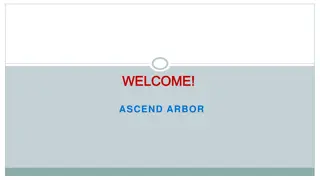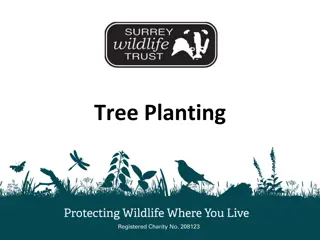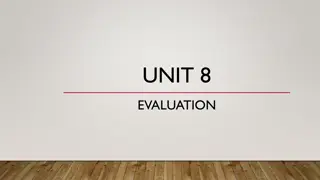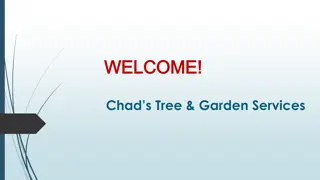Evaluation of Communications Needs for Tree Planting & Maintenance at Chesapeake Riparian Forest Buffer Workshop
This evaluation project aims to gather and synthesize existing products and campaigns, along with direct feedback, to assess the communications needs of partners, practitioners, and technical service providers. The workgroup consists of members from various organizations who utilized methods such as surveys, interviews, and focus groups to identify key knowledge and resources needed for effective communication in advancing forestry outcomes.
Download Presentation

Please find below an Image/Link to download the presentation.
The content on the website is provided AS IS for your information and personal use only. It may not be sold, licensed, or shared on other websites without obtaining consent from the author. Download presentation by click this link. If you encounter any issues during the download, it is possible that the publisher has removed the file from their server.
E N D
Presentation Transcript
Evaluation of Communications Needs to Increase Tree Planting and Maintenance Presented to Chesapeake Riparian Forest Buffer 2022 Leadership Workshop March 16, 2022 Steve Raabe President, OpinionWorks, LLC
Evaluation Purpose Evaluation Purpose Gather and synthesize existing products and campaigns, Gather and synthesize existing products and campaigns, coupled with direct feedback and a more detailed assessment coupled with direct feedback and a more detailed assessment of the communications needs of our partners, practitioners of the communications needs of our partners, practitioners and technical service providers. and technical service providers. This project will identify key knowledge, products and This project will identify key knowledge, products and resources needed to communicate more effectively, while resources needed to communicate more effectively, while advancing forestry outcomes. advancing forestry outcomes.
Project Workgroup Project Workgroup Rachel Felver, Communications Director, CBP Jake Solyst, Web Content Specialist, CBP Julie Mawhorter, Mid-Atlantic Urban and Community Forestry Coordinator, USFS Sally Claggett, Liaison to the Chesapeake Bay Program, USFS Katie Brownson, Watershed Specialist, USFS Craig Highfield, Director, Chesapeake Forests, Alliance for the Chesapeake Bay
Methods Methods Survey of Forestry Professionals (Jul Survey of Forestry Professionals (Jul- -Aug 2021) Peer-to-peer distribution Crowd-sourcing of campaigns 289 responses Resulted in database of 119 campaigns Aug 2021) Formative Interviews (Sep 2021) Formative Interviews (Sep 2021) One-on-one interviews with 5 campaign managers/stewards Identified key issues for deeper review Focus Groups among Practitioners (Nov 2021) Focus Groups among Practitioners (Nov 2021) 2 groups held among buffer campaigns 6 participants in each group
Our Lens: Our Lens: Outreach & Engagement Outreach & Engagement
Context Context Lack of Resources for Tree Maintenance Lack of Resources for Tree Maintenance Implications for public outreach and engagement I want to second the notion about maintenance. I know that's not an outreach issue, but it becomes an outreach issue when you're talking with a landowner and they say, So what happens when the trees die? Or what do I need to do to take care of this? " If you have an unsuccessful buffer and the tubes are laying all over and it looks terrible and you see it from the road, it's not a very good impression and other landowners aren't interested in having a mess on their property either.
Context Context Difficulty Hiring and Retaining Staff Difficulty Hiring and Retaining Staff We're not getting any additional help, but we are now managing, as individuals, way more acres of buffers every year and we're not taking any off the list. Strained Tree Supply Strained Tree Supply
Outreach Successes Outreach Successes #1: Building Relationships #1: Building Relationships Often a long process Trust and listening are key By the time I get a buffer in the ground, I have been talking to these people for at least a year. So they know me, and they know I'm going to call them and tell them, Hey, I'm sending the interns out. This is what they're going to do. I'll let you know. This year we actually sent out formal letters and let them know what their survivability was in their buffer. And that went over pretty well. So I think we'll continue to do that, but so I guess I'm kind of saying the outreach has passed just getting new participants. It's keeping the people who have already committed to it. Knowing what's going on with their buffer and happy about it."
Outreach Successes Outreach Successes #3: A Collaborative, Spark #3: A Collaborative, Spark- -Plug Leader Visionary, relational and communicative, entrepreneurial, and seemingly tireless Innovate programs and approaches Mentor other practitioners Plug Leader We have check-in calls and all the counties call in and we share things that are going well, (and) things that aren't going well. And then because we have her and she's connected to everyone, she's my go-to person when I'm having an issue, and she can usually give me some pointers or what someone else has done"
Outreach Successes Outreach Successes #6: Simple, Flexible Program Design and Approach #6: Simple, Flexible Program Design and Approach Filling gaps in funding Facilitating applications Making things easier We started to hear from landowners, rural landowners, a lot of farms in our area, that they wanted to participate in riparian buffer programs, such as through Soil and Water or NRCS, but for whatever reason, the program stipulations didn't work for them. So really we just started as a way to fill the gap. So bring in some funding to be able to do these projects for farms where a typical cost share program didn't work for them."
Outreach Successes Outreach Successes #8: Authentic Neighbor #8: Authentic Neighbor- -to to- -Neighbor Recommendations Neighbor Recommendations Leverages the most trusted relationships If a landowner has a good experience, he's going to tell their neighbor or other people that they associate with. There's tons of different meetings that farmers are putting on for themselves to talk about different practices They kind of talk to each other and they trust each other. So attending those meetings instead of creating another meeting to be like, Hey, you guys come to us. You kind of go to them.
Gaps Gaps (Selected) (Selected) Understanding the motivations of non Understanding the motivations of non- -ag audiences Tree program managers are often unfamiliar with public Tree program managers are often unfamiliar with public engagement techniques engagement techniques Lack of consistent, systematic mentoring Lack of consistent, systematic mentoring Information sharing about individual landowners Information sharing about individual landowners Lack of funding for outreach tools, evaluation Lack of funding for outreach tools, evaluation ag audiences
Recommendations Recommendations Aggregate communication tools, messages, best practices Aggregate communication tools, messages, best practices Image library Audience research Outreach tools Systematize collaboration and information Systematize collaboration and information- -sharing Support technical assistance for public outreach Support technical assistance for public outreach sharing
Evaluation of Communications Needs to Increase Tree Planting and Maintenance Presented to Chesapeake Riparian Forest Buffer 2022 Leadership Workshop March 16, 2022 Steve Raabe President, OpinionWorks, LLC























